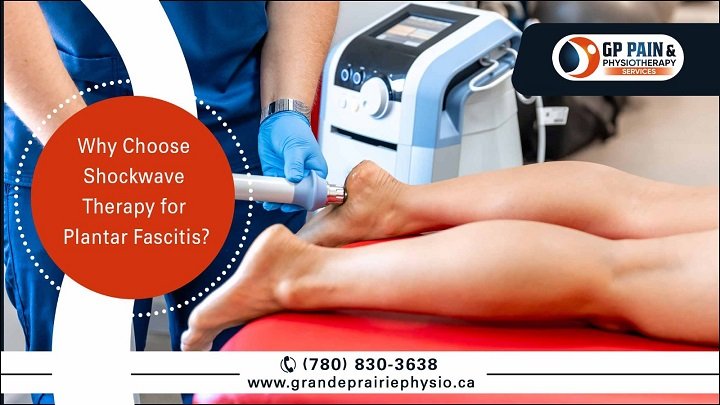Plantar fasciitis is a rather painful foot condition that affects the thick band of tissues known as the plantar fascia. Shockwave therapy Grande Prairie is an effective treatment option for plantar fasciitis, offering pain relief and promoting long-term healing.
Plantar Fasciitis: Causes And Symptoms
Plantar fasciitis is commonly characterized by a sharp pain in the heel, often described as stabbing or throbbing, especially after waking up in the morning or standing after long periods of rest.
Symptoms include foot stiffness, which can make movement difficult, increased pain with prolonged walking, running, or standing on hard surfaces, and tenderness in the heel or arch when pressed. The condition develops when the plantar fascia, a ligament supporting the arch, becomes strained or inflamed.
Common causes include overuse from prolonged standing or high-impact activities, improper footwear with poor arch support or cushioning, and flat feet or high arches, which alter weight distribution and strain the fascia. Obesity also adds pressure to the plantar fascia, increasing the risk of inflammation, while age-related tissue weakening makes it more common in individuals aged 40 to 60.
How Shockwave Therapy Works for Plantar Fasciitis
Shockwave therapy in Grande Prairie uses high-energy sound waves to help stimulate the body’s natural healing processes. Here’s how it works and why it’s effective for plantar fasciitis:
- The therapy works by stimulating tissue repair through microtrauma, which triggers increased blood flow and healing cell activity in the plantar fascia. This process helps repair damaged tissues and restore function.
- In addition to repairing tissue, shockwave therapy reduces pain and inflammation by breaking down calcified deposits in the plantar fascia and reducing nerve sensitivity. This leads to both immediate and sustained relief from the chronic pain often associated with plantar fasciitis.
- Shockwave therapy referred as Extracorporeal Shockwave Therapy, boosts circulation to the affected area, further nourishing the tissue and speeding up the recovery process. The procedure’s noninvasive nature means no surgery or anesthesia is required, making it a convenient and low-risk option. Sessions are brief, typically lasting 15 to 20 minutes, and most patients notice significant improvement after just 3 to 5 sessions, with minimal downtime.
What to Expect During Shockwave Therapy
- During a shockwave therapy session for plantar fasciitis, the process begins with lying comfortably, usually on a treatment table. The affected foot, typically the heel or arch where the pain is most concentrated, is exposed, and a special gel is applied to the skin. This gel serves as a conduit to help the sound waves pass efficiently from the handheld device into the tissue without any loss of energy.
- Once the gel is applied, the therapist uses a handheld shockwave device to deliver high-energy sound waves to the plantar fascia. These sound waves are administered in a series of controlled pulses, targeting the area of pain and inflammation. The patient may feel a tapping sensation as the sound waves penetrate the tissue, which some describe as mildly uncomfortable but not overly painful. The intensity of the treatment can be adjusted depending on the patient’s tolerance level and the severity of the condition.
- Each session typically lasts for 15 to 20 minutes. The exact duration depends on the size of the treatment area and the severity of the plantar fasciitis. For most patients, shockwave therapy is completed in a series of 3 to 5 sessions scheduled over a few weeks. The interval between sessions allows the body to begin its natural healing process in response to the microtrauma induced by the sound waves.
- After the treatment, some patients experience mild soreness, swelling, or redness at the site where the sound waves were applied. These side effects are typically short-lived, and last only a day or two. They are similar to the soreness felt after an intense workout and are generally not severe enough to interfere with daily activities.
- The recovery period following shockwave therapy is minimal, making it a convenient option for individuals who wish to avoid invasive procedures like surgery. Patients resume their regular activities shortly after each session. However, it’s advised to avoid high-impact activities like running or jumping for a few days to allow the plantar fascia to begin healing properly.
- Significant improvement in pain and function is usually noticeable after just a few sessions, although the degree of relief varies depending on the individual and the severity of the condition. For many, ESWT therapy offers long-term relief from the chronic pain of plantar fasciitis, reducing the need for pain medications or more aggressive interventions like injections or surgery.
Why Choose Shockwave Therapy for Plantar Fasciitis?
Shockwave therapy has become a choice for treating plantar fasciitis for several key reasons:
- Non-invasive: Unlike surgery or injections, shockwave therapy doesn’t require cutting into the tissue or introducing medication into the body. This reduces the risk of complications.
- Minimal downtime: Patients usually return to their regular activities after each session. This makes shockwave therapy ideal for individuals with busy lifestyles and for those who want to avoid extended recovery times.
- High success rate: Studies have shown that shockwave therapsignificantly reduce pain and improves functional abilityvement in people with plantar fasciitis. Many patients experience long-term relief after completing the treatment.
- Alternative to surgery: For those seeking a treatment option without relying on painkillers or undergoing surgery, shockwave therapy offers a safe solution.
Is Shockwave Therapy Right for You?
Shockwave therapy in Grande Prairie provides an innovative and effective treatment option for plantar fasciitis, especially for individuals looking for non-invasive pain relief. This therapy is well-suited for those suffering from chronic heel pain. If you are struggling with plantar fasciitis, shockwave therapy might be the answer. Consult with our team at GP Pain Physiotherapy to see if this therapy is a good fit for your condition. Contact GP Pain Clinic to help you get back on your feet pain-free.


